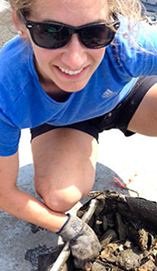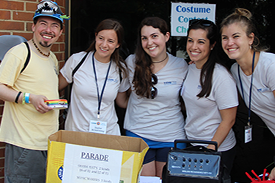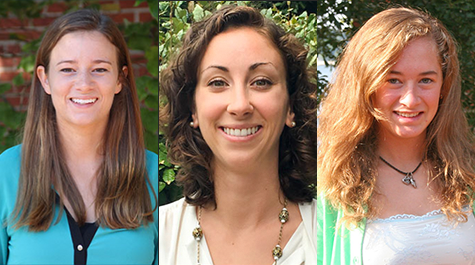VIMS students play prominent role through Knauss Fellowships
Three graduate students from William & Mary’s School of Marine Science at the Virginia Institute of Marine Science are currently using their science to better inform ocean-related decision-making in our nation’s capital.
Taylor Armstrong, Melissa Karp, and Julie Snock-Hurgronje recently began their yearlong placements with legislative and executive offices in Washington, D.C. as John A. Knauss Marine Policy Fellows made possible through NOAA’s National Sea Grant Program.
Named after one of the co-founders of the Sea Grant program, former NOAA administrator John A. Knauss, the Knauss Fellowship program provides a unique educational experience for graduate students interested in ocean, coastal, and Great Lakes resources and the policy decisions affecting those resources.
Armstrong, a current master’s student scheduled to graduate later this year, was placed with NOAA’s Ocean Acidification Program. Karp, a recent master’s graduate, was placed with the National Assessment Program of NOAA Fisheries’ Office of Science and Technology. Snock-Hurgronje, another recent master’s grad, was placed with the minority office of the Senate Committee on Commerce, Science, and Transportation’s Subcommittee on Oceans, Atmosphere, Fisheries, & Coast Guard.
The VIMS Legacy
The selection of three VIMS students to this year’s Knauss class continues a tradition as old as the program itself. Since the Knauss Fellowship was created in 1979, VIMS has placed 44 of the 90 students selected from Virginia institutes of graduate education, good for 1st in the Commonwealth and tied with the University of California, Santa Barbara for 4th in the nation.
Associate Dean of Academic Studies Linda Schaffner attributes the high number of program participants from VIMS to the unique learning environment provided to students. “William and Mary’s School of Marine Science at VIMS puts a strong focus on preparing graduate students to address societal and global challenges in estuarine, coastal, and marine systems,” says Schaffner. “We recruit terrific students, strong in academics as well as communications and people skills.”
 Karp cited the experience of learning at VIMS as influencing her interest in policy. “My thesis project at VIMS dealt with the ecosystem services provided by oyster reefs and had both restoration and management implications,” says Karp. “This further peaked my interest in policy and desire to pursue a career in the field.”
Karp cited the experience of learning at VIMS as influencing her interest in policy. “My thesis project at VIMS dealt with the ecosystem services provided by oyster reefs and had both restoration and management implications,” says Karp. “This further peaked my interest in policy and desire to pursue a career in the field.”
Karp says that VIMS’ mandate to advise and be involved in Virginia’s coastal resources creates an environment where students can participate in management discussions and be included in discussions with entities such as the Virginia Marine Resources Commission.
Echoing her classmate, Armstrong cited her opportunity to pursue a sub-concentration in Marine Policy while working in the laboratory and taking higher-level chemistry classes as crucial to her development.
For Snock-Hurgronje, an earlier position with the South Carolina Department of Natural Resources sparked an interest in ocean policy and fisheries management that she continued to pursue with a dual Master’s degree in Public Policy and Marine Science from W&M and VIMS. As a dual student, she researched jurisdictional-overlap issues and conflict management among stakeholders through her capstone project on oyster management in Virginia and Maryland.
“It was through the joint degree program that I was able to combine my interest in both science and policy,” says Snock-Hurgronje. “We had the flexibility to create new opportunities to integrate both disciplines in projects for both programs.”
These experiences are not unique, says Schaffner. “Our students take policy-related courses offered by School of Marine Science faculty, or take advantage of partnerships with the W&M Public Policy Program and the Law School that allow them to take formal coursework in policy and law on W&M's main campus.”
The Road Ahead
Already well into their placement periods, the three students are optimistic about the upcoming year and the steps beyond their Fellowship.
 In her role with NOAA, Armstrong is looking forward to assisting in the creation of the fourth National Climate Assessment, an ongoing effort among government agencies to assess the current effects of climate change and how government, citizens, communities, and businesses can create environmentally sound plans moving into the future.
In her role with NOAA, Armstrong is looking forward to assisting in the creation of the fourth National Climate Assessment, an ongoing effort among government agencies to assess the current effects of climate change and how government, citizens, communities, and businesses can create environmentally sound plans moving into the future.
Snock-Hurgronje says her time on Capitol Hill will prove invaluable for gaining skills useful for navigating the nexus between science and politics and pushing for policy decisions made on sound science. “I’m really looking forward to learning about the ins and outs of the legislative process, and getting to work on issues such as those facing fisheries,” says Snock-Hurgronje. After the fellowship, Snock-Hurgronje would like to continue to work for a government agency or environmental non-profit while focusing on marine policy issues.
Beyond participating in the interface between science and management and pursuing her current efforts to advance NOAA’s National Stock Assessment Program, Karp is also looking towards interacting with new audiences, such as Congressional staffers and lawmakers. “Regardless of what I pursue next, says Karp, “I think having a strong understanding of the intricacies of how science, management, and policy interact will make me better at whichever path I choose to go down next.”


